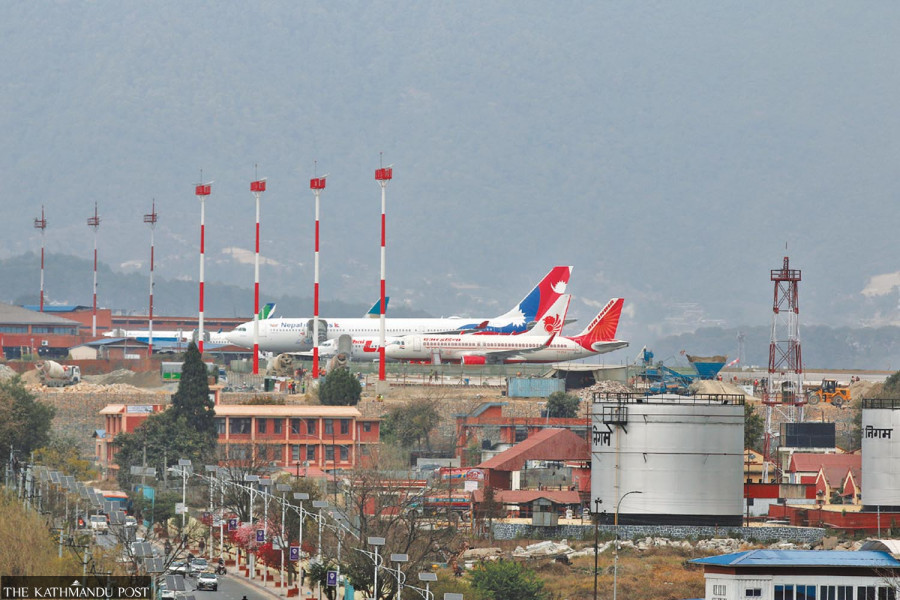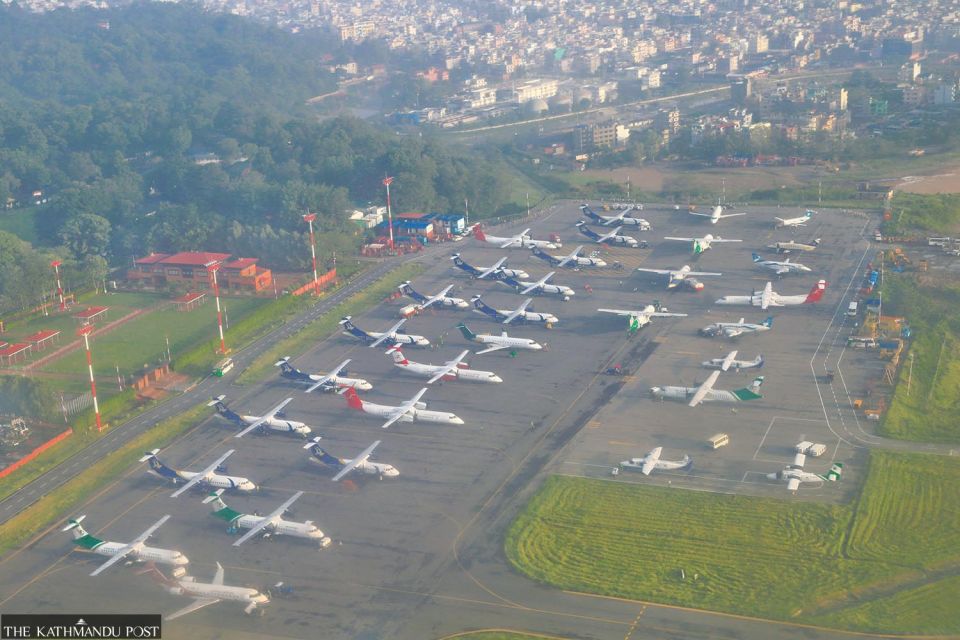
Nepal Airlines found out the hard way what the Civil Aviation Authority of Nepal could do if you caused it displeasure. On October 30, the regulator cancelled its scheduled flight to Delhi as punishment for defying instructions to move some of its international services to Bhairahawa's empty airport.
Nepal Airlines' jet remained on the ground, and more than 500 passengers suffered as a result of the last-minute cancellation.
The incident raised questions about whether the regulator had the authority to tell airlines what to do so it could promote another airport.
Industry experts and Tourism Ministry officials said it was "illegal" to force airlines to serve particular airports, and that it was a display of the regulator's hegemony.
The Civil Aviation Authority performs dual functions as regulator and service provider. As service provider, it runs two international airports—Tribhuvan International Airport in Kathmandu and the newly opened Gautam Buddha International Airport in Bhairahawa.
“If the regulator tells airlines they have to operate flights from its other airports, it is a total conflict of interest to promote business, not safety,” said Sanjiv Gautam, former director general of the Civil Aviation Authority. “The October 30 incident is really serious.”
Several unnamed experts told the Post that the civil aviation body has been misusing its authority but no one wants to speak against it for fear of retaliation.
“How can a regulator force airlines to 'go here and there' to fulfil its interest to promote business?”
International airlines have been given a mid-December deadline to move some of their flights to Bhairahawa.
Global aviation watchdogs have questioned the civil aviation body’s dual role and urged Nepal to split the organisation into two entities—service provider and regulator—to enhance the safety of flyers. But the government has shown no interest in doing so, and Nepal's aviation industry is suffering the consequences.
On Thursday, the European Commission continued its ban on Nepali airlines for not meeting international safety standards. They remain on the updated EU Air Safety List which means they are still barred from EU skies even after nearly 10 years.
According to the Official Journal of the European Union published on Thursday, the European Commission has said, “As part of its continuous monitoring activities, on September 14, 2022, the commission met with the representatives of the Civil Aviation Authority of Nepal (CAAN). On that occasion, the CAAN provided the commission with information regarding the safety oversight in Nepal and notably their revised considerations about the functional separation of the regulatory and service provider roles which is a longstanding issue identified during the commission consultations with Nepal, as well as by the International Civil Aviation Organisation (ICAO) Universal Safety Oversight Audit Programme.”
This means the Civil Aviation Authority of Nepal has communicated it will not be fragmented into regulator and service provider.
Nepali experts say the civil aviation body has offered no strong logic why it doesn’t want this functional separation.
The European Commission added in its report, “As a follow-up to that meeting, on November 10, 2022, the CAAN submitted to the commission the information and documentary evidence about the adoption of a new CAAN regulation, which in CAAN’s view ensures the functional separation of CAAN’s regulatory and service provider roles, namely by preventing the transfer of staff between regulatory and service provider sections of the CAAN.”
The report states, “The implementation of this new regulation and progress in aligning the CAAN’s safety oversight with the relevant international safety standards would allow the commission to consider whether a European Union on-site assessment visit to Nepal should be organised in 2023. On the basis of evidence gathered during such a visit, the commission could assess if a removal of air carriers certified in Nepal would be justified.”
Following the September 2012 crash of Sita Air Flight 601 at the Manohara River which killed 19 people, including seven British citizens, the European Commission imposed a blanket ban on Nepali airlines from flying into the 27-nation bloc in December 2013.
The European Commission has said at this time there are no grounds for amending the list of air carriers which are subject to an operating ban within the Union with respect to air carriers from Nepal.
“Member states should continue verifying the effective compliance of air carriers certified in Nepal with the relevant international safety standards through prioritisation of ramp inspections of those air carriers.”
 Several unnamed experts told the Post that the civil aviation body has been misusing its authority but no one wants to speak against it. Post File Photo
Several unnamed experts told the Post that the civil aviation body has been misusing its authority but no one wants to speak against it. Post File Photo
The chief of the civil aviation body Pradip Adhikari has been repeatedly saying to Nepali media that they will work from two offices instead of splitting the organisation.
Insiders say there is larger politics to prevent the organisation from being separated. They say that once it is broken up, some top position holders will lose the dual benefits they have been enjoying.
The existing system allows the director general of the Civil Aviation Authority to issue tenders for multi-billion-dollar projects. The same person also has the plum job of overseeing compliance with the project and the aviation regulations governing the issuance of licences to airlines and crews.
“No one wants to lose this scope and power. That’s why, despite intense pressure, it has become hard to separate the civil aviation body for a long time,” insiders say.
“It’s a shame that Nepal is still on the air safety list even after nearly 10 years,” said aviation analyst Hemant Arjyal. “It may impact Nepal’s tourism industry and the economy in the long run.”
The Civil Aviation Authority has been repeatedly issuing assurances that the European Commission will remove Nepal from the air safety list, citing ICAO's audit report which shows that the country's safety standard has improved some.
There are eight critical elements that ICAO considers essential for a state to establish, implement and maintain in order to have an effective safety oversight system.
But ICAO’s final audit report, a copy of which the Post has obtained, shows that Nepal’s performance on organisation, which defines the organisational structure needed to meet safety standards, remains poor.
The effective implementation score on organisation, one of the eight critical elements, has been reduced to 45.45 percent from the earlier 50 percent. The global average is 71.1 percent.
In its final audit report, United Nations aviation watchdog ICAO formally asked Nepal to split the civil aviation body into two entities—service provider and regulator.
"The request has come in written form after Nepal showed no eagerness to separate the organisation and ensure that there is no conflict of interest even after 10 years," said Gautam, former chief of the aviation body.
Splitting the organisation is a crucial organisational reform agenda which has been a work in progress for the last one and a half decades.
“The reluctance to listen to the aviation watchdogs will cost Nepal in the long run. Although Nepali airlines don’t fly directly to the EU, tourists, particularly in the high-end segment, are reluctant to travel to countries that have been flagged by the aviation watchdog,” said Arjyal.
"Nepal has been receiving backpackers, the low-end segment of tourists, who usually don't care much whether it’s safe to fly in Nepal or not; but for the luxury segment, safety matters very much," said Arjyal.
Travel and tour operators say that the travel insurance premium of tourists visiting Nepal increases every time the European Commission updates its air safety lists. They fear that other countries may impose stricter travel advisories as Nepal has remained on the air safety list even after 10 years.
Nepal remains red-flagged in international aviation because of its poor safety record. Passing legislation to split the Civil Aviation Authority of Nepal into two entities will fulfil a key requirement of the European Commission.
This will hasten Nepal’s removal from its air safety list, allowing Nepali airlines to fly to Europe and bring more tourists, but the government is unwilling to break up the aviation agency and loosen its grip on it, insiders say.
Nepal’s tourism and aviation sectors lamented that Parliament’s five-year term ended on September 18 without passing long-pending civil aviation bills to separate the civil aviation body, which could severely impede their growth and do long-term damage.
Insiders say the hospitality industry has been pouring billions into new properties amid post-Covid optimism that tourist arrivals would take off, but failure to pass the bills could stop recovery in its tracks.
Successive tourism ministers and political leaders have been constantly pledging to the diplomatic community that Nepal will pass the bills and start the process to have the country removed from the bad books of the European Commission.
The Post unsuccessfully made repeated attempts to contact officials at the Civil Aviation Authority of Nepal for their reaction.












